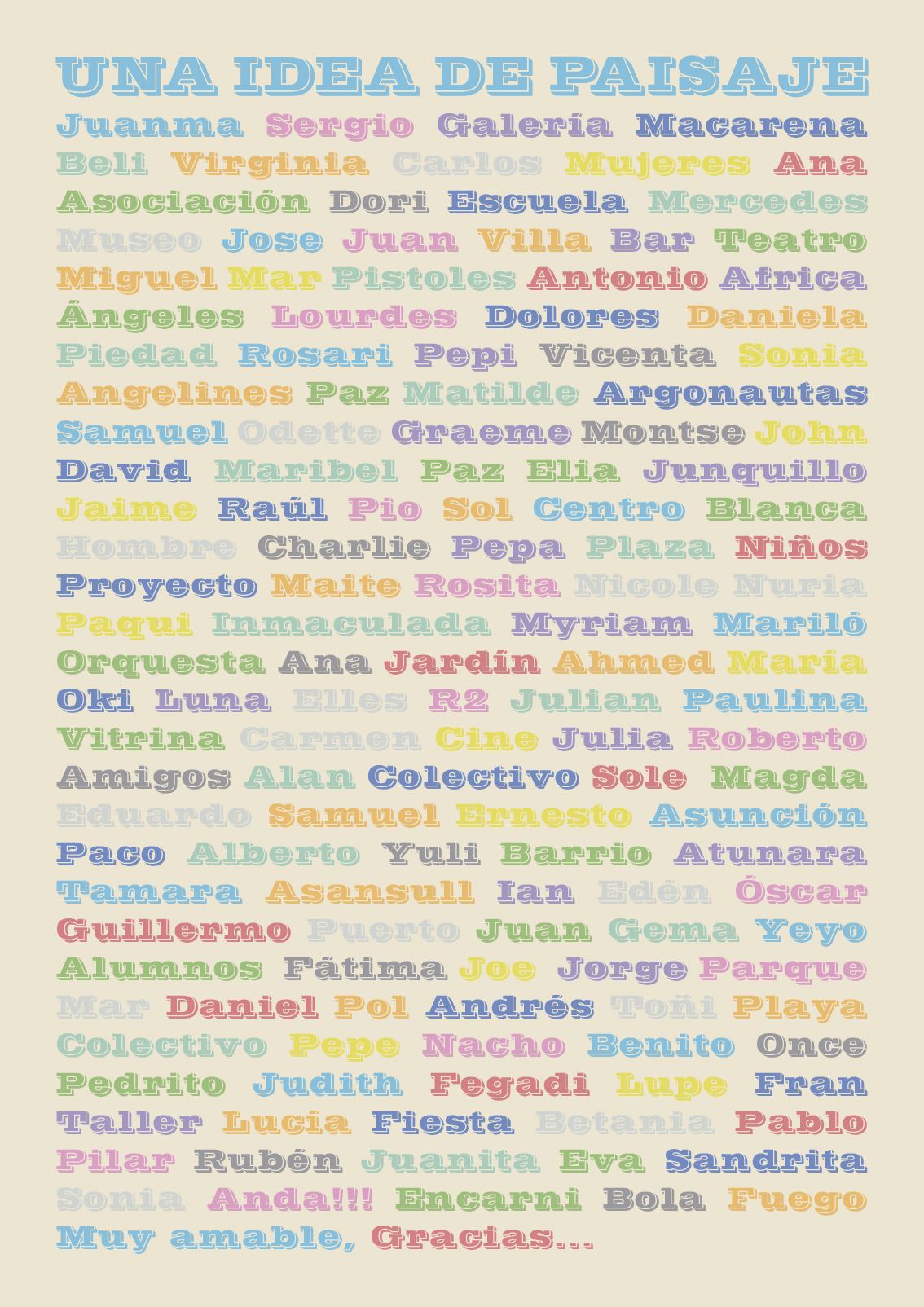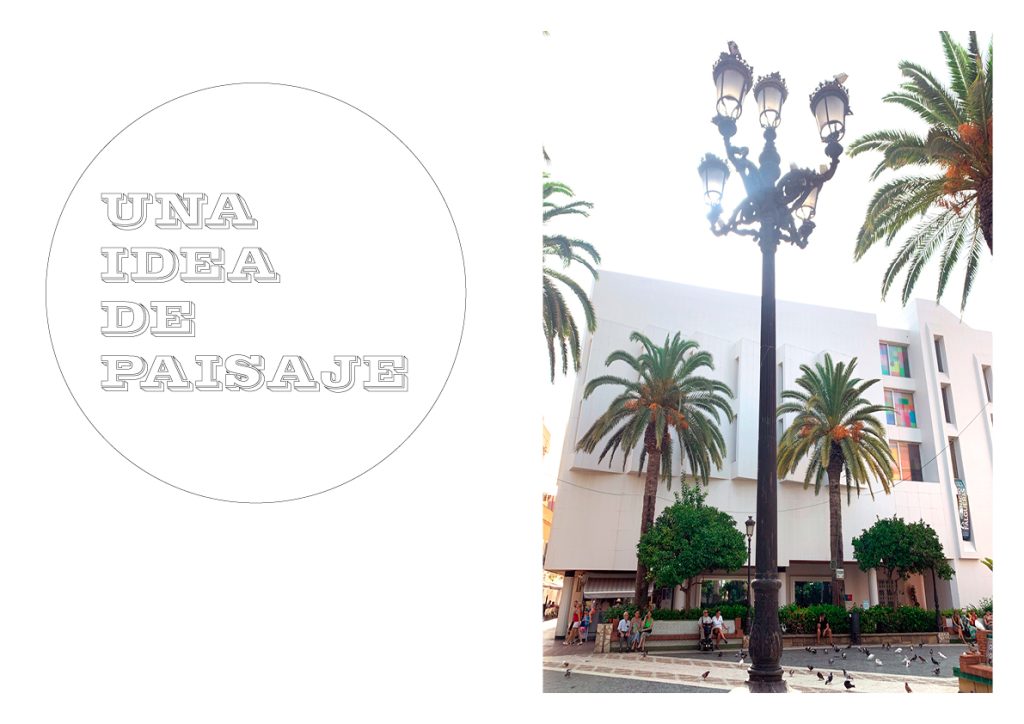
Una idea de paisaje
La Línea, Cádiz. Marzo/junio 2022
Descargar publicación
El paisaje es una proyección emocional, existe y se construye dentro del espectador; pero es también el espejo donde nos miramos, la imagen en la que nos vemos reflejados.
Observar y observarnos con atención supone por tanto ver, reconocer y descubrir esos “paisajes” que nos definen y se extienden alrededor. Es un proceso que nos hace más sensibles y responsables con nosotros mismos, con los otros y con nuestro entorno.
El paisaje es privado, o al menos lo es la idea que cada uno de nosotros imaginamos y construimos, pero al mismo tiempo es un reflejo de nuestra sociedad. Puede ser un ente abstracto, pura metáfora, o una estampa real y reconocible. Un espacio pequeño e íntimo, o un lugar estremecedor sobre el que volcamos nuestros recuerdos, percepciones y vivencias: nuestra habitación, nuestro barrio, la ciudad, el bosque, las montañas, la mar, las ensoñaciones, el más allá…
Tradicionalmente, el paisaje ha sido entendido como un lugar indómito o salvaje: selvas, desiertos, océanos, cumbres y valles, escenarios naturales inmensos y sublimes que nos conectan con el animal que llevamos dentro. Sin embargo, esa “idea” de paisaje se ha ampliado y diversificado en nuestro mundo, donde resulta habitual hablar de paisaje urbano, distópico o postnatural, así como de paisajes de la memoria, sonoros, literarios, e incluso más recientemente de los paisajes virtuales que nos envuelven.
An idea of landscape
La Línea, Cádiz. March/June
Download publication
The landscape is an emotional projection, it exists and is constructed within the spectator; but it is also the mirror in which we look at ourselves, the image in which we see ourselves reflected.
Observing and observing ourselves with attention therefore means seeing, recognizing and discovering those «landscapes» that define us and extend around us. It is a process that makes us more sensitive and responsible with ourselves, with others and with our environment.
The landscape is private, or at least it is the idea that each of us imagine and build, but at the same time it is a reflection of our society. It can be an abstract entity, pure metaphor, or a real and recognizable image. A small and intimate space, or a thrilling place on which we pour our memories, perceptions and experiences: our room, our neighborhood, the city, the forest, the mountains, the sea, the dreams, the beyond…
Traditionally, landscape has been understood as an untamed or wild place: jungles, deserts, oceans, peaks and valleys, immense and sublime natural settings that connect us with the animal within us. However, this «idea» of landscape has expanded and diversified in our world, where it is common to speak of urban, dystopian or post-natural landscapes, as well as landscapes of memory, soundscapes, literary landscapes, and even more recently of the virtual landscapes that surround us.

Dirigido por Macarena Alés, comisariado por Juan Carlos Bracho y coordinado por Beli Lara y Raúl González, Una Idea de Paisaje se planteó como un proyecto desde el que abordar esa “idea” a través de las más variadas disciplinas y materias: artes plásticas, artesanía, arquitectura, teatro, el sonido, la palabra o el baile, entre otros. El resultado de estos ejercicios se materializó y desarrolló con propuestas de naturaleza clásica e incluso académica, junto a otras actividades más experimentales, ofreciendo un panorama amplio y sin fronteras –ni conceptuales ni estéticas- sobre un género que intermitentemente ha recorrido la historia del arte y el pensamiento.
Una Idea de Paisaje se construyó como un cuerpo de trabajo colaborativo y sin jerarquías definidas. Diferentes voces y sensibilidades dibujaron en el proceso un arcoíris plural, un paraguas de haceres y perfiles que fueron de lo profesional a lo amateur: artistas autodidactas, estudiantes, noveles, profesionales de media carrera o figuras consagradas; individualidades, colectivos y asociaciones… Todos sumaban para hacer cómplices a quien se animara a participar.
Muesta de esta actitud es la portada de esta publicación, donde se han utilizado los nombres de pila de los colaboradores y los espacios donde se han desarrollado los proyectos para, metafóricamente, poder proyectarnos e identificar con ellos.
Durante trece semanas –siguiendo ese cronograma hemos estructurado también esta publicación- la Galería Municipal Manolo Ales y las calles de La Línea se transformaron en un laboratorio de arte y acción intergeneracional, transversal e inclusivo, para un aprendizaje colectivo donde casi todo fue posible.
Directed by Macarena Alés, curated by Juan Carlos Bracho and coordinated by Beli Lara and Raúl González, Una Idea de Paisaje was conceived as a project from which to approach that «idea» through the most varied disciplines and subjects: visual arts, crafts, architecture, theater, sound, words or dance, among others. The result of these exercises materialized and developed with proposals of a classical and even academic nature, together with other more experimental activities, offering a broad panorama without borders -neither conceptual nor aesthetic- on a genre that has intermittently traversed the history of art and thought.
An Idea of Landscape was built as a collaborative body of work without defined hierarchies. Different voices and sensibilities drew a plural rainbow in the process, an umbrella of activities and profiles that ranged from the professional to the amateur: self-taught artists, students, novices, mid-career professionals or consecrated figures; individuals, collectives and associations… All of them added up to make accomplices of whoever dared to participate.
The cover of this publication shows this attitude, where the first names of the collaborators and the spaces where the projects have been developed have been used to metaphorically project and identify with them.
For thirteen weeks -following this chronogram we have also structured this publication- the Manolo Ales Municipal Gallery and the streets of La Línea were transformed into a laboratory of art and intergenerational action, transversal and inclusive, for a collective learning where almost everything was possible.























































































































